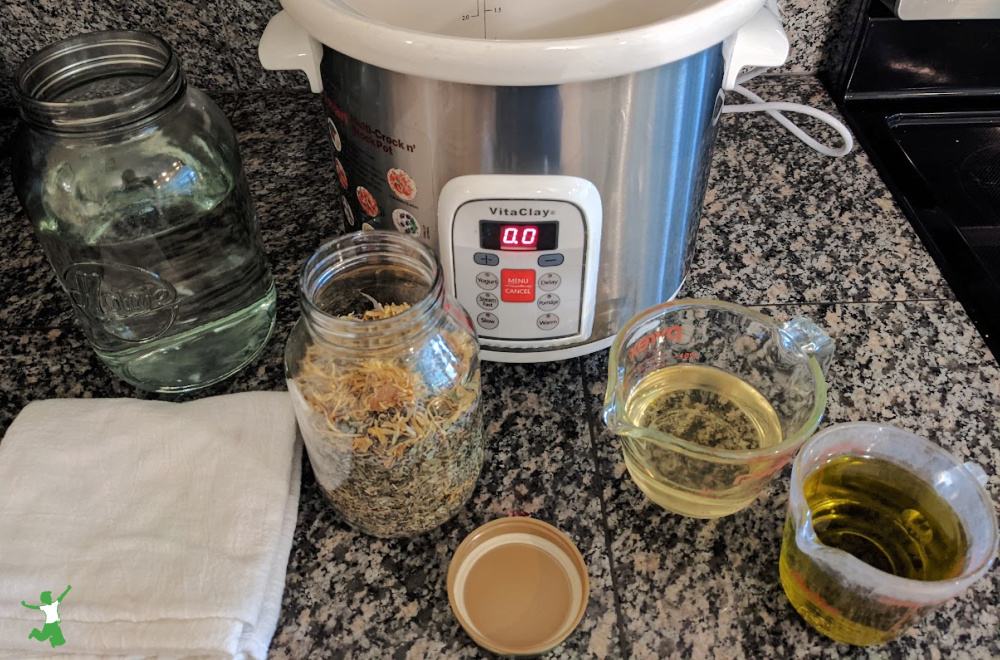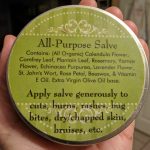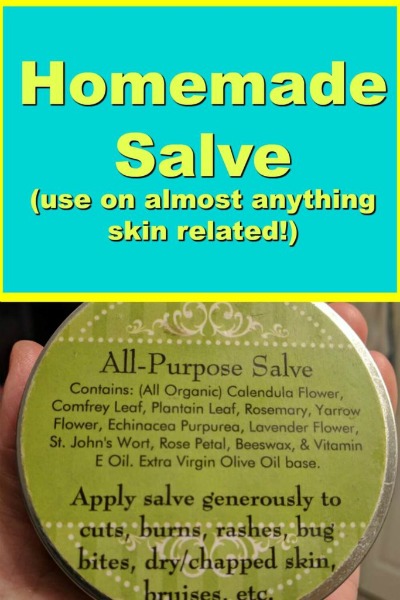All purpose herbal salve recipe with nine different therapeutic herbs including comfrey for rapid tissue healing and inflammation reduction. Great for burns, bruises, rashes, insect bites and moisturizing.

When it comes to salve, I much prefer one that will work for nearly all situations and challenges the skin may encounter. This simplifies things considerably! Everyone knows exactly what to grab and use when a skin problem crops up. It also keeps your medicine cabinet free of unnecessary tubes and jars that are confusing to sort through.
A couple of years ago, I tried a comfrey salve that functions in this manner. I originally purchased it from a local herbalist-in-training and over time, have found it to be the most effective salve I have ever tried.
My family and I have discovered that this comfrey salve works so well that we basically don’t use anything else when we have a skin problem, whether sunburn, bruise, insect bite, windburn, mild rash, or a kitchen scalding. In fact, anytime I bump or burn myself, I get this salve on the area as fast as possible as more often than not, it will prevent any sort of bruise or burn from forming.
Once I scalded about one-third of my hand as I was straining bone broth from the stockpot. I thought for sure my hand would be burned for weeks and possibly even scarred. I can’t even begin to describe how much it hurt.
Fortunately, I put a generous amount of this comfrey salve on it fast and kept reapplying until the pain subsided (which took a while). Would you believe, the skin never turned that beet red/purple color that usually indicates a bad burn. What’s more, the skin never even peeled.
Unfortunately, my herbalist friend is no longer making her homemade creations, so I’ve had to learn to make this comfrey salve myself. Fortunately, she generously shared her recipe with me so I can make and continue to use it. This turned out to be a good thing, as it is super easy to do even if you have little to no experience using herbs medicinally.
Why Comfrey for a Salve?
Used for millennia to help heal burns, sprains, bruises, and even slight bone fractures, comfrey contains allantoin which is thought to speed up the production of new cells. It’s also known as knitbone. Even its Latin name, symphytum, is derived from the Greek, “symphis”, meaning growing together of bones, and “phyton,” meaning plant.
Other Important Herbs
The healing power of comfrey to the skin and connective tissues is enhanced by five other herbs contained in this salve recipe.
- Echinacea both in its root (more potent) and leaf form is included to provide natural antibiotic properties.
- Yarrow flower also helps counter infection, stop the pain and encourage rapid healing, particularly with sunburn and kitchen burns.
- Rosemary leaf brew is an effective wash for the skin and wounds of all kinds. It also acts as a natural preservative for the salve.
- Plantain leaf, when included in an ointment, helps to counter stings, stop itches, heal wounds, and relieve pain.
- Calendula flower is included because it is useful on all external skin problems and injuries but especially those that are red, tender, and oozing. This helpful herb will also help to heal burns, bruises, and sprains. Calendula decreases swelling, clears infection, speeds tissue regeneration, and prevents scarring.
Making Your Own Salve is Easy!
While you are welcome to include any other herbs you feel would be helpful in an all-purpose salve, the ones listed above are the ones I have found to be super effective. As I mentioned before, this comfrey salve is the only one we currently use in our house for anything skin related.
It also works as a mild herbal antifungal as well.
The recipe below makes about 2 cups of herbal salve. You only need to make a batch every few years. It lasts a long time! It also makes great gifts if you divide it up into small jars to give away to friends and family.
Prefer to Buy?
There isn’t anything commercial on the market that can compare to homemade. However, if you just don’t have the time to make your own comfrey salve, you can buy a couple of similar ointments on the market.
My Mother-in-Law swears by Christopher’s Complete Tissue & Bone ointment which contains a generous amount of organic comfrey. In addition, this brand of comfrey creme will produce good results.
Another excellent remedy for bug bites and bruises that costs pennies is old-fashioned Witch Hazel.

Herbal Salve Recipe with Comfrey
All purpose medicinal herbal salve containing 9 helpful herbs including comfrey for all types of skin problems including rash, kitchen burns, sunburn, bruises, insect bites, dry/chapped skin etc.
Ingredients
- 3 oz Comfrey leaf
- 3 oz Plaintain leaf
- 3 oz Calendula flower
- 3 oz White Yarrow flower
- 3 oz Rosemary leaf
- 3 oz Echinacea purpurea root
- 3 oz Echinacea purpurea leaf
- 3 oz St. John’s Wort
- 3 oz Lavender flower
- 2+ cups Extra virgin olive oil or virgin coconut oil
- 6 oz beeswax
Instructions
-
Fill non-BPA lid mason jar two-thirds full of the herb mix above in roughly similar amounts. This is about 3 ounces by volume for each herb.
-
Gently liquefy the oil if necessary (coconut oil liquefies at 76 °F/24 °C).
-
Add the oil until it fills the mason jar. Leave one inch at the top. Screw on the lid tightly.
-
Keep on low heat (be very careful not to boil the oil as it needs to be hot to infuse the herbs, but never boiling) for 72 hours. As water evaporates, add more water to maintain the proper level.
-
After 3 days, the oil will be darkened and ready to use. Strain out the herbs using a cheesecloth or an old white cotton shirt. The comfrey infused oil may now be used as is for a wonderful massage oil.
-
To transform the oil into a salve, you need to add beeswax (get it here). Depending how much oil you have once the herbs are strained out, add 3 ounces/85 grams of grated beeswax (or beeswax pastilles) for every cup of oil. Warm the mixture together in a medium sized pot on low heat until the wax is melted. Stir gently to distribute the wax evenly. Add a drop of Vitamin E oil or wheat germ oil per 1 ounce/28 grams of oil if you desire additional natural preservative effect beyond what the rosemary provides.
-
While the salve is still warm, pour into containers of choice. Salve tins work especially well.
-
Let the containers sit until the oil hardens. Screw on the lids and be sure to label and date each one.
Recipe Video

More Information
How to Prepare an Herbal Infusion
Traditional Remedies for Modern Families
How to Make a Vinegar Compress for Bruises and Sprains
Bruise Easily? Here’s the Nutrient You Need
Wise Woman Herbal by Susun Weed








Are the herbs dry?
Yes
How come there aren’t any measurements? All equal parts? Going to make this and have no idea how much to buy or use…
The first instruction says to fill a mason jar two-thirds full with the dry herbal ingredients in roughly equal amounts. There are seven herbs in the recipe and a mason jar is one quart, two-thirds of a quart is 21 oz, so it’s about 3 oz per herb. Hope that helps.
If you use 1/3 cup per each herb, you’ll be close to the 3 oz mark. (1/3 cup = 2.64 oz.)
We’re can I get this in nz
Hi Sarah,
I made this balm yesterday using 85g beeswax per cup of oil and my balm is so hard I can’t use it.
Regards,
Angela
I was an avid user of comfrey, both internally and externally in the 1970’s-1980’s. When it first became prohibited for internal use, I read the original study used to condemn comfrey. Long time past and by memory only, but I remember one had to drink over 40 gallons a day for MONTHS in order for liver toxicity to occur.
Comfrey is not as toxic as it is made out to be. This was based off of a study performed on rats where the fed rats 30 times there body mass. Of course that will cause problems! I drink comfrey root and leaf tea every day!!!! I also put on open wounds and heals super fast. I am still alive…..
Are the herbs you use dried or fresh when you use them? I have access to fresh comfrey but everything else is dried.
FYI: If you are not interested in making your own salve, may I recommend a wonderful product made by the sisters of the Holy Nativity convent. It’s very inexpensive, very soothing and all natural. The product is called Gilead’s Balm. an all natural beeswax balm. Please check it out. They also make beeswax candles that I use. You can reach them at http://www.holynativityconvent.com. It’s a wonderful way to support these very health minded sisters. They are kind, caring and responsive.
When we winter in FL I always use this product to soothe our northern guests over-exposure to sun. Mother Effie is head of Holy Nativity. I hope you will check them out. Here is list of ingredients: sweet almond oil, coconut oil, jojoba oil, beeswax, olive oil, shea butter, cocoa butter, water, aloe vera gel, vitamin E, honey, lemongrass oil, rosemary oil.
I was reading one of the reviews for the Dr. Christopher’s formula on Amazon and there is a caution on the label that reads:
“Warning: External use only. Consuming this product may cause Liver damage. This product contains Comfrey. Comfrey contains pyrrolizidine alkaloids, which may cause serious illness or death. This product should not be taken orally, used as a suppository, or applied to broken skin. For further information contact the Food and Drug Administration.”
So, I did a little research and found that Comfrey (particularly the roots) does have these compounds and should definitely not be ingested. That being said, it is not listed as a poisonous or toxic plant on any poison control sites. ????
Anyway, I have small kids and wondering if this would be safe to plant in my yard. Which was my intention to begin with, then I got excited when I saw your post, but now I am wondering again…. Any light on that?
Correct, you should not eat this salve.
Comfrey can be invasive, so put it in a spot where it can be controlled
This is a good recipe, but I’d like to make a few suggestions.
First, the recipe will be much more effective if fresh, not dry herbs are used.
Secondly, any one of the herbs makes a great salve or oil, so don’t hesitate to try whichever one you have on hand. Plantain is particularly effective and is easy to find.
Finally, it’s far easier, albeit slower, to use the cold infusion method. Chop the fresh herbs, put them in a jar, and pour the oil of your choice over them. Stir with a chopstick to remove any air bubbles. Leave for a month and strain. The problem with the method above is that if any steam enters your oil and condenses to liquid, your oil is more likely to turn rancid quite quickly.